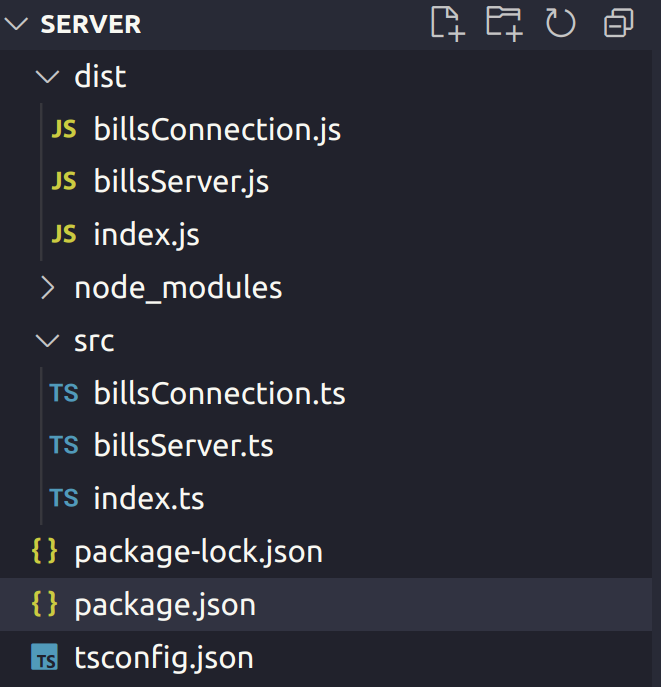Websockets: Difference between revisions
Jump to navigation
Jump to search
| Line 174: | Line 174: | ||
Javascript is dead - long live the king | Javascript is dead - long live the king | ||
==Setting up Typescript== | ==Setting up Typescript== | ||
Found this a bit of challenge first time through but it seems to work. Here is the project setup. | Found this a bit of challenge first time through but it seems to work. Here is the project setup.<br> | ||
[[File:TS Setup Project Structure.png| | [[File:TS Setup Project Structure.png| 300px]]<br> | ||
<syntaxhighlight lang="bash"> | <syntaxhighlight lang="bash"> | ||
npm i -D typescript | npm i -D typescript | ||
</syntaxhighlight> | </syntaxhighlight> | ||
Revision as of 21:48, 31 July 2022
Pros and Cons
Pros
- Full Duplex (no polling)
- Http compatiable
- Firewall friendly
Cons
- Proxy is tricky
- L7 Load Balancing challenging (timeouts)
- Stateful, difficult to horizontally scale
Simple JS example
Client
<html>
<body>
<script>
const ws = new WebSocket("ws://localhost:3100")
ws.addEventListener("open", () => {
console.log("We are connected")
ws.send("hello everyone")
})
ws.addEventListener("message", (e) => {
console.log("We have data", e)
})
</script>
</body>
</html>
Server
We need to npm install
"dependencies": {
"ws": "^8.8.1"
}
And run this.
const Websocket = require("ws")
const wss = new Websocket.Server({port: 3100})
wss.on("connection", ws => {
console.log("New Client Connected")
ws.on("message", (data) => {
console.log("Client Sent", data)
ws.send(data.toUpperCase())
})
ws.on("close", () => {
console.log("Client Disconnected")
})
})
Another example
This one uses websocket library - npm i websockets
const http = require("http");
const WebSocketServer = require("websocket").server
const port = 3100
let connection = null;
//create a raw http server (this will help us create the TCP which will then pass to the websocket to do the job)
const httpserver = http.createServer((req, res) =>
console.log("we have received a request"))
//pass the httpserver object to the WebSocketServer library to do all the job, this class will override the req/res
const websocket = new WebSocketServer({
"httpServer": httpserver
})
httpserver.listen(port, () => console.log(`My server is listening on port ${port}`))
//when a legit websocket request comes listen to it and get the connection .. once you get a connection thats it!
websocket.on("request", request => {
connection = request.accept(null, request.origin)
connection.on("open", () => console.log("Opened!!!"))
connection.on("close", () => console.log("CLOSED!!!"))
connection.on("message", message => {
console.log(`Received message ${message.utf8Data}`)
connection.send(`got your message: ${message.utf8Data}`)
})
//use connection.send to send stuff to the client
sendevery5seconds();
})
function sendevery5seconds() {
connection.send(`Message ${Math.random()}`);
setTimeout(sendevery5seconds, 5000);
}
//client code
//let ws = new WebSocket("ws://localhost:8080");
//ws.onmessage = message => console.log(`Received: ${message.data}`);
//ws.send("Hello! I'm client")
Bills Server
This is an attempt to manage connections in a server process
let failedConnections = []
class BillsServer {
constructor() {
this.index = 0
this.connections = []
this.loop()
}
addConnection(connection) {
connection.on("close", () => {
failedConnections.push(connection.id)
console.log(`closing socket for ${connection.id}`)
})
connection.on("message", message => {
console.log(`Received message ${message.utf8Data}`)
})
this.connections.push(connection)
}
loop = () => {
setInterval(this.process, 5000);
}
process = () => {
console.log("Current connections: ", this.connections.length)
if(this.connections.length > 0) {
this.processAll()
if(failedConnections.length > 0) {
console.log(`Removing ${failedConnections.length} failed connections`)
this.connections = this.connections.filter((connection) => !failedConnections.includes(connection.id))
console.log(`${this.connections.length} Remaining Connections`)
failedConnections = []
}
}
}
processAll = () => {
for(let i = 0; i < this.connections.length; i++) {
try {
console.log(`${i.toString()}: Processing connection`,this.connections[i].id)
this.handleConnection(this.connections[i])
}
catch(e) {
console.log(`${i.toString()}: Got an error handling connection`, e ? e : "Unknown error")
}
}
}
handleConnection = (connection) => {
console.log("Sending to client", connection.id)
connection.send(`Sending you greetings`)
}
}
module.exports = BillsServer
Bills Server Typescript
Javascript is dead - long live the king
Setting up Typescript
Found this a bit of challenge first time through but it seems to work. Here is the project setup.

npm i -D typescript